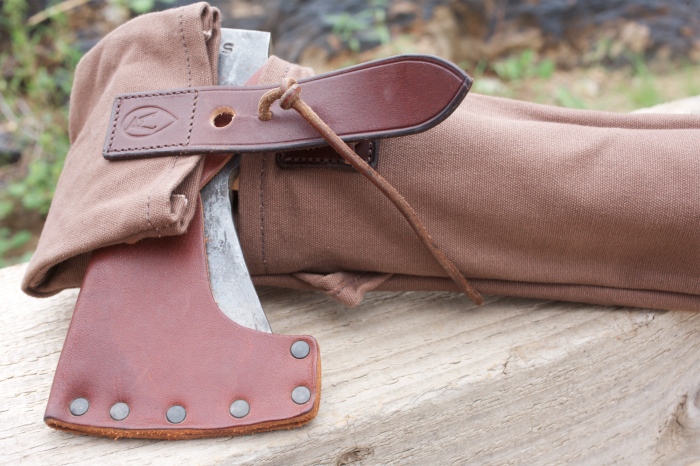Swedish steel meets English wood
(WARNING: If you are annoyed by unapologetic encomiums to fine, hand-crafted tools made one at a time by one person at a time, do not read further!)
Some time ago I splurged on a Gränsfors Bruks Scandinavian Forest Axe, after eyeing them for years. If you aren’t familiar with the brand, Gränsfors Bruks has been making axes and hatchets in Sweden since 1902. While countless other companies—including some fine American brands—gradually sacrificed quality for quicker, cheaper production, Gränsfors Bruks took a step backward in the 1980s and returned to making only best-quality tools. Craftsmen in the forge in Hälsingland stand before fearsome flywheel-driven trip hammers to form the heads, then stamp their initials in the steel (mine was made by Kjell-Åke Sjölund). After annealing, tempering, and sharpening, an oiled hickory handle is inserted with a hydraulic press, then fixed with two wedges, one wood and one steel.
The result is as elemental a tool as humans can make, the latest iteration in an unbroken line dating to the first time a Neolithic tinkerer lashed a knapped hunk of flint to a stick and discovered the magic of force multiplication.
My Scandinavian Forest Axe looks almost dainty next to a standard American felling axe (which Gränsfors Bruks also makes, along with such intriguing anachronisms as throwing axes and replicas of 7th-century bearded axes). Just 25 inches long and 2.6 pounds, I can choke up on it one-handed to lop small limbs off a larger branch, or back off to a two-fisted grip and power through a six-inch-diameter trunk in 30 seconds flat. It wouldn’t be my first choice for building a Dick Proenneke-style cabin in the North Woods, but if pressed it could probably handle it—and it’s nearly perfect for every job I’m likely to encounter around the house or on an overland journey.
But . . . sometimes you need a saw.
An axe is unexcelled at certain tasks: splitting logs, quickly trimming branches off larger limbs, notching logs, cutting through green wood that can bind a saw, or sharpening stakes made from branches. Of course your axe also makes a decent hammer for pounding in those stakes.

A saw is a more precise instrument. It’s generally faster for cutting through dry wood, and produces less waste. If you need to trim trailside overgrowth, a saw can take off a limb surgically at the node, leaving the shrub or tree looking more natural.
The axe is of course the more “dangerous” tool, capable of cleaving tibias as well as trees. However, while I’ve never experienced an injury from a hatchet or axe, I have suffered innumerable nasty tearing cuts from carelessly handled saws, and my acquaintances report similar histories. I theorize the perceived “danger” in swinging an axe might induce sensible people to be more careful with it than they are with a saw. So I’ll call that comparison a draw—as long as you use both tools properly.
So—which saw to carry with my fine Swedish axe?
I own a couple of good folding saws—a Gerber Sports Saw and a Bahco Laplander. Both are excellent for limbs up to about three inches in diameter, and the compact configuration allows them to fit into tight spots. But they’re fairly light-duty tools. For bigger logs, and more comfortable extended use, I prefer a bow or buck saw, and since the buck saw can be broken down, it makes the most sense for a vehicle.
I looked at the clever Trail Blazer buck saw, which collapses to fit into its own handle tube. However, its 18-inch blade offers little advantage over a folding saw. Besides, as a companion to the Gransfors axe its all-metal construction seemed rather soulless. What I needed was a wood-framed model. I thought I had it when I browsed through the Lehman’s site (lehmans.com) and discovered their beautiful hickory buck saws, which are made by a local Amish craftsman. Excellent—except the Lehman’s saw wasn’t designed to be broken down quickly, and its 28-inch blade rendered it a bit too large for most field use.
Finally, a burst of recovered memory led me to the Woodlore site (raymears.com) in England. Founded by Ray Mears, the avuncular English survival expert whose television programs are a refreshing antidote to the gritted-teeth epics from the strictly-for-entertainment bug-eating fringe, Woodlore’s online shop offers a modest selection of high-quality gear—and in the saw section, there it was.
The Woodlore folding buck saw collapses in seconds when not in use, and the just-right 24-inch blade is tensioned with a simple Spanish windlass arrangement, which helps keep total weight down to less than two pounds including a fine canvas and leather case that incorporates a slot for the saw and another that accepts—ready?—a Gränsfors Bruks Scandinavian Forest Axe.
Sold.
Not that I needed more convincing, but I was pleased to discover the Woodlore saw is made by Chris Boyton, an English longbow maker well known to me (I once made my own longbow, and Chris’s work was an inspiration and template). The wood is light but strong European beech of excellent, straight grain, and the included Bahco blade simply whizzes through logs up to five inches in diameter without shifting, or ten inches if you roll it and make a second cut from the other side.
 So now I’m delighted to own an elegant pairing of axe and saw that carry together perfectly, complement each other’s strengths, and should last a lifetime. And I know the names of the craftsmen who made each one—a rare thing in our world.
So now I’m delighted to own an elegant pairing of axe and saw that carry together perfectly, complement each other’s strengths, and should last a lifetime. And I know the names of the craftsmen who made each one—a rare thing in our world.

